
There is a 99% chance your business is a small to mid-sized enterprise (SME), a business with under 500 employees.
The No. 1 thing all businesses need (no matter their size) is competitive differentiation - standing out from your peers and convincing the prospect to buy from you vs. the other guy.
So, if all businesses have the same problem, do all businesses approach competitive differentiation the same way?
No. SMEs have a harder time with it. Big companies are marketing-centric. They have money to create branding and advertising. SMEs are more sales-centric and more dependent on face-to-face selling. They don’t have big budgets to create brand imagery. Their “brand” is typically individuals. They are far more dependent on personal interaction, face-to-face selling, pressing the flesh.
But, what has the internet created and the Coronavirus disease (COVID-19) accelerated?
The internet has created a platform for consumers to pre-review your company without your active input. Go/no decisions are made based on perception of satisfaction of need. These decisions are being made before you can have a face-to-face. This was already occurring, but COVID-19 accelerated it.
And, what is the top thing consumers are looking for and that companies can differentiate by having?
Environmental sustainability certification.
Corporate sustainability searches are up 800%. Seven out of 10 consumers (B2B and B2C) will move their business if they find a certified sustainable company offering the same product/service. This translates to $2-plus trillion in prospect spending looking to move to certified sustainable companies.
So, how are certified sustainable SMEs that promote their certification as a differentiation tool performing against their non-certified competitive peers?
They are growing dramatically faster.
Studies show over 75% overall growth (some studies go as high as 2,000%); 67% investor ROI; 24% net income; 15% sales gains; 11% EBITDA for certified sustainable companies vs. their non-certified competitive peers.
So, in summary, is sustainability certification worth considering?
Yes. If seven out of 10 consumers want to change, it is a good thing and you will differentiate and make more money. Therefore, it is worth checking out.
How do you find what is right for your company?
Below are the eight components you should look for in a sustainability certification program.
1. Employee performance/health enhancement. Sustainability is not just about energy savings or greening up. It is about people and how people grow and prosper in the environment, without destroying the environment. If a program, claiming to be a sustainability certification, does not have a “people piece” that can quantify improvement in the performance and health of the employees of the business, it is not a true sustainability program. Every organization in the world suffers from the Big 5 – employee insomnia, stress, anxiety, physical pain and mental acuity. Studies show the cost of the Big 5 to U.S. organizations is $7,000-12,000 in lost sales per year, per full-time employee. Net, if you have 100 employees, you are losing $700,000-$1,200,000 per year, due to employee insomnia, stress, anxiety, physical pain and mental acuity. Net, we start with this point, as it typically has the biggest economic impact on an organization.
2. Certify the business, not the box. People care about things that affect people. Building-centric certifications care about the energy reduction of the building (ie, box), but are not interested in what goes on inside the box, which is what people care more about. This includes things like people, water, waste, safety, community, vendors, clients, etc. Further, and this is where the revenue-side benefits of a true sustainability program can start for you, building-centric programs are hard to promote and tie to sales/revenue. It is hard to grow sales by saying “buy more of my product as I operate in an energy efficient building.” But, with a true sustainability certification of your business (including people), that statement becomes “buy more of my product as it is made by a sustainable company.” This is what people respond to.
3. Third-party audit. Regardless of the industry, any certification or accreditation program must have a third-party audit process to maintain credibility. Just like when you were in school and needed to pass the tests, which were reviewed/audited by your teachers to get credit for the class, there needs to be an independent party that verifies if the organization pursuing/receiving the certification truly did the things it claimed to have done. Without this, an organization can make exaggerated claims and the certification loses credibility and value to the marketplace.
4. Use a respected and integrated global standard to maximize credibility. The sustainability industry is maturing and coalescing around a few key standards that cover sustainability certification, carbon neutrality, UN Sustainable Developmental Goals (SDGs) and environmental, social and corporate governance (ESG) planning. If you want to maximize the market’s positive response to your organization’s receipt of a sustainability certification, select a standard that is globally known, respected and integrated into all the programs and protocols the world is following.
5. Promotion of the certification. When you are selecting a sustainability certification program and want to benefit on the revenue-side of your P&L, pick a program that recognizes the promotional value of being certified sustainable and incorporates promotion into its service to help you maximize your differentiation and revenue-side benefit.
6. Continual improvement. Some programs establish a very high initial bar. These can be expensive, time-consuming, frustrating, and in many cases, unattainable. It is hard to get people to change. It is even harder if you set the bar too high, as it will scare them. So, find a program that lets you come as you are and follows the concept of continual improvement. This will allow your organization to start from wherever it is, move at its own pace, achieve goals, enjoy the process and start believing in the benefit of always striving to be a little bit better.
7. Annual update – current = credible. You want a program that annually updates and includes the date as part of the certification.
8. Cost. Yes, we could have started with this, as cost is always a factor. But, we end with it, as the above define the value you are seeking. Then, the components of your cost include a) the money you pay for the certification; b) the money you pay for the improvements to qualify for the certification; c) the cost of the audit (if it is a legitimate program); and d) the cost of your staff’s time. You need a certification program that delivers on the above seven points without crashing on any of the four components of cost.
The good news is there are sustainability certification programs that deliver on all eight of the above points.
You will be doing the right thing for the environment.
Your staff will be happier, healthier and more productive.
Your costs will go down.
You will be differentiating your company from its peers, which will have a positive impact on your brand and sales effort.
















